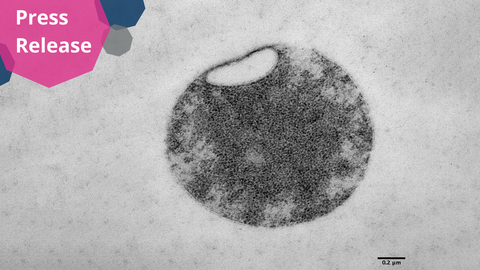Nov 21, 2024
Exploring Life at Its Simplest: Scientists Create a "Minimal Cell Membrane" with Just Two Lipids

Transmission Electron Microscopy image of a minimal cell, JCVI-Syn3A, with only two types of lipids. While half of the cells maintained a normal shape, minimizing the lipidome led to this "Death Star" phenotype, characterized by a membrane deformation (light region at the top of the cell).
Lipids, or fats, are essential to life. They form the membranes around cells, protecting them from the outside. In nature, there is an enormous diversity of lipids, with each organism having its own unique combination. But what are the minimum lipid requirements for a cell to survive? A research team at the B CUBE - Center for Molecular Bioengineering at TUD Dresden University of Technology showed that cells can function with just two lipids. They created a cell with a minimal, adaptable membrane, offering a unique platform to study how lipid complexity evolved and how it can be engineered for synthetic life. Their findings were published in Nature Communications.
Membranes are like bubbles that encapsulate cells and separate them from their surroundings. Membranes also serve as platforms where molecules interact, coordinating processes essential to life.
“There is an enormous diversity of lipids in nature, and almost every organism has its own set of lipids, known as lipidome. Human cells, for example, employ hundreds of different types of lipids,” says Dr. James Sáenz, research group leader at the B CUBE who led the study. “Yet, these different mixtures of lipids, all provide solutions to the same key evolutionary challenges: creating a stable barrier and organizing biomolecules in space and time. We want to understand why so many different lipids evolved, why life needs them, and how they can be used to engineer synthetic living systems.”
Testing the Limits of the Lipidome
For their study, the group started with Mycoplasma mycoides, a naturally simple pathogenic bacterium. Unlike most cells, Mycoplasma cannot make its own lipids and must instead use those provided by its host. By systematically supplementing cells with different lipid combinations, the researchers narrowed down the essential combination needed for survival and division.
They found that the cells can survive on a “diet” of just two lipids: cholesterol and another so-called bilayer-forming lipid, phosphatidylcholine.
“These two lipids are not necessarily the only ones that could support life,” says Isaac Justice, the Ph.D. student who carried out the project. “But having both a bilayer-forming lipid, which provides the basic structure for the cell membrane, and a non-bilayer-forming lipid, such as cholesterol, which adds stability, seems to be a fundamental requirement.”
The Surprising Effects of a Two-Lipid Diet
The team observed the cells with a minimal lipid diet under an electron microscope and saw dramatic effects on cell shape and size. Some cells grew up to ten times their usual size, while others formed unusual shapes and deformations.
“What surprised me most,” says Justice, “was that about half of the cells with only two lipids appeared completely normal. They were round and divided well. Despite the drastic reduction in lipid complexity, they continued to function surprisingly well.”
The Challenge of Reducing Complexity
Arriving at this minimal lipid combination was no easy task. Initial experiments showed that Mycoplasma could modify most of the lipids they were fed, transforming them into new types.
“When we provided cholesterol and a common bilayer phospholipid, the cells were able to generate about 30 different lipids from them,” explains Dr. Sáenz. To control the minimal lipid composition, the team supplied cells with very similar lipids but connected with a different kind of chemical bond that the cells were not able to break down with their enzymes.
Reverse Engineering the Complexity of Life
Having identified the minimal lipid diet, the researchers applied it to a “minimal cell” called JVCI-Syn3A, which was engineered at the J. Craig Venter Institute to contain only the genes essential for survival. Now, with both a minimal genome and lipidome, this cell provides a powerful new tool for synthetic biology.
This minimal cell system provides a unique platform to study how lipids support life. Using the principles of bottom-up synthetic biology, researchers can now reintroduce different parts of the lipidome in a directed way and explore the corresponding changes in cell function.
“You can think of it as reverse engineering the evolution of lipid complexity. We are not necessarily recreating the lipids that were present in ancient life. We could not. We just don’t know what these are. Instead, we are reintroducing complexity back to the membrane in a systematic, step-by-step way,” says Justice.
“By finding the minimal lipid requirements for a living cell, we now have an experimental platform to understand why certain lipid structures evolved and how they support life,” says Dr. Sáenz. “This knowledge could one day help us design synthetic cells with bespoke membranes for special applications in biotechnology and medicine.”
Original Publication
Isaac Justice and James P. Sáenz: A tuneable minimal cell membrane reveals that two lipids suffice for life. Nature Communications (November 2024)
Link: https://doi.org/10.1038/s41467-024-53975-y
About B CUBE
B CUBE – Center for Molecular Bioengineering was founded as a Center for Innovation Competence within the initiative “Unternehmen Region” of the German Federal Ministry of Education and Research. It is part of the Center for Molecular and Cellular Bioengineering (CMCB). B CUBE research focuses on the investigation of living structures on a molecular level, translating the ensuing knowledge into innovative methods, materials and technologies.
Web: http://www.tu-dresden.de/cmcb/bcube
High-resolution picture: https://tud.link/6vmaps
